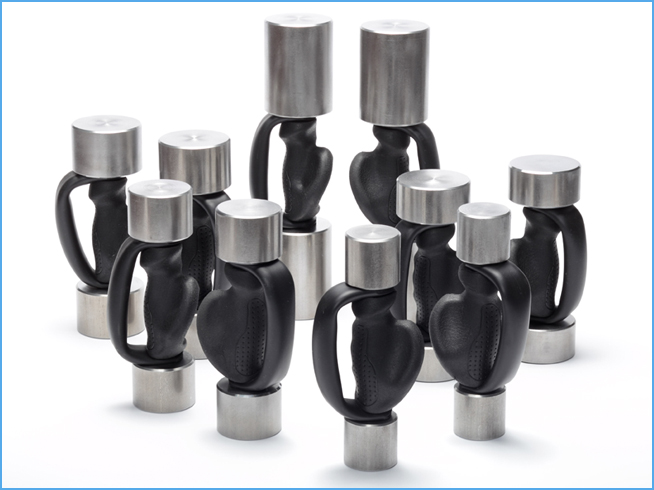A pretty strong statement, is it not? After all, haven't the conditioning 'experts' so consistently and steadfastly belittled the value of our favorite exercise tools.
Well, stand proud iron men; one very astute researcher has demonstrated conclusively through scientific and medical findings, personal example, and thousands of test cases that weights, indeed, are the answer.
Dr. Leonard Schwartz, a 59-year old psychiatrist from Pittsburgh, Pennsylvania, is the author of
Heavyhands, a fascinating text which many feel will totally revolutionize modern fitness training. Not entirely content with current aerobic programs, Dr. Schwartz had the fortitude to go his own way and search for a better means of achieving endurance, muscle strength, and cardiopulmonary health. Through considerable study, thought, experimentation, and imagination he devised a unique system of dumbbell training which has proven capable of producing higher levels of aerobic power than any other activity. Schwartz's fact filled book offers thorough documentation to clearly indicate that his simple, rather odd lifting program will vastly improve any athlete's capabilities.
What exactly is Heavyhands training?
What does is offer bodybuilders, weightlifters, and other body conscious folks?
Well, to best explain the system, its development, and its physiological effects no better example can serve than Leonard Schwartz's own incredible story.
At 50 years of age a worried Dr. Schwartz took stock of his poor physical condition. Uncomfortably he pondered the accumulated ills of the 25 years of sedentary living which had been forced upon him by a busy professional schedule. Jogging was the aerobic craze at the time and seemed like a safe, easy way to edge back into reasonable shape. After initial success, the doctor took to this activity with a vengeance even beyond that of most over-enthusiastic 'reborn' trainees.
His running proved stimulating and enjoyable for quite a while but eventually reached a plateau where measurable physiological gains came to a standstill. Any attempt at increasing running speed to make the activity progressive and more intensive simply led to injury. So, while dutifully chugging up and down Pittsburgh's steep hills, Schwartz began asking himself, "Could there be a better, more exciting means toward cardiovascular fitness than this? Must I be content with merely maintaining the modest physical level I've achieved? There has to be some form of exercise which could boost my aerobic capabilities even higher."
Reading extensively in the fields of exercise physiology and sports medicine for an answer, Schwartz became quite impressed with cross country skiers. Their pole pushing activities gave them far greater oxygen consumption rates than displayed by most endurance athletes. "Wouldn't it make more sense," he thought, "to involve the arms and upper body in aerobic exercise, as do these skiers, rather than constantly restrict total attention to the legs?"
Fondly recalling the weight training he did as a teenager, Schwartz theorized that various dumbbell movements such as curls and lateral raises would force the arms to work against gravity much the same as legs do in propelling the body. Of course, due to the time required by aerobics (at least 12 continuous minutes), the dumbbells would have to be kept light enough to allow for extremely high reps and sufficiently comfortable to avoid hand cramping during the lengthy exercise. Best of all, though, the little 'bells could be easily pumped without interfering with SIMULTANEOUS LEG MOVEMENTS. By coupling upper with lower body exercise it was felt, upon receiving some support from research literature, that maximum workloads could be imposed on the body and more calories burned within a given time span. Also, unlike other aerobic activities, equal employment of the arms could have a profound effect on the upper body musculature and strength.
At first the good doctor startled his neighbors by jogging over familiar sidewalks while rapidly curling a pair of 3-pound dumbbells. This felt so good that other variations were sought and tested. Later his repertoire of simultaneous exercises expanded to include over 100 movements, each able to develop total body fitness by itself or in combination with any of the others. Calisthenics duos such as front lateral raises while leg kicking, shrugs and squats, jump twists, ski poling with weights in place of poles, shadow boxing maneuvers and a multitude of others kept his experiments lively.
Enthusiasm for the new system skyrocketed when many tests with complex laboratory apparatus indicated that this exercise pioneer's cardio-respiratory and muscular endurance had increased dramatically as had his upper body strength and running speed. At the same time his resting pulse rate (now 35) and bodyfat percentage dropped to astonishingly low levels.
Most important, an end to these physiologic miracles was nowhere in sight; unlike activities such as jogging, cycling, or rope skipping, in this exercise the hands could always be made 'heavier' and moved faster to allow for continued physical progress.
The doctor was literally flabbergasted to discover that the tests proved his gains in aerobic power greatly surpassed what preliminary projections had indicated was possible. This was even hard for
him to accept until he was jolted by a rather startling personal incident. It seems during his jogging days that he often enjoyed running the steps to his 12th floor office during lunch breaks. Eventually he peaked exactly 60 seconds for this feat, a time which periodic attempts indicated was an absolute limit. But one day, on a whim, Schwartz decided to check what effect his now well trained ARMS would have on this winding, vertical sprint. By pulling himself up the banisters while running, he cut an astounding 12 second off his previous best!
"This is really it!" he beamed. "Now I'm absolutely convinced the arms and legs together can surpass any physical goals determined by either set of limbs individually!"
The doctor's experiments did indeed break new ground, proving conclusively that no single exercise nor even circuit training schemes can work the body as thoroughly as a simultaneous HeavyHands movement, or offer anywhere near the benefits.
Shortly thereafter, Dr. Schwartz began teaching his techniques to many men and women of varying ages and athletic abilities. Everyone was surprised by how easy the distributed workload of HeavyHands seemed in comparison to traditional lung busting, leg dominated endurance activities. Practically every student became wildly excited over his progress and the class dropout rate was just about nil. Many others across the country experienced similar results and stimulation after.
HeavyHands was published in 1982. Of course, further proof of the book's impact took shape in the form of several imitative systems which quickly popped up.
Discovering HeavyHands to be a terrific aerobic supplement to my powerlifting routine,
http://ditillo2.blogspot.ca/2009/05/john-mckean-part-one.html
http://ditillo2.blogspot.ca/2009/05/john-mckean-part-two.html
http://ditillo2.blogspot.ca/2009/06/john-mckean-part-three.html
and seeing other important applications for weight training in general, I found myself quite intrigued with this new method an the man behind it. Recently I met with Dr. Schwartz and acquired further insight into his training philosophy and rather phenomenal accomplishments.
As we shook hands and exchanged greetings, my eyes were instantly drawn to an amazing set of arms which hung relaxed from the man's short-sleeved shirt. Although I've observed many fine physiques during 23 years in the iron game I can hardly recall anyone who impressed me with such shapely, well defined biceps and triceps. Not too shabby either was the pronounced V-taper leading from thick, wide deltoids down to a tiny 26-inch waist. Could this 5'7", 135 pound package of lithe muscularity belong to an almost 60-year old man?
"Facially I may be an old geezer, but I'm 20 from the neck down!" laughed Dr. Schwartz. "Really, though, looks are not that important to me. It's how well the body FUNCTIONS that is of most concern. I just let the function determine the structure; all body sculpting takes care of itself."
Of course, the function Schwartz delights in most is the performance of his daily HeavyHands workout. These sessions are, to put it mildly, DIFFERENT. When seeing him in action very few people understand his attempts to involve as much muscle mass as possible at one time. Most bodybuilders, for instance, would be awestruck to watch him rapidly swing a pair of dumbbells around for non-stop half-hour periods or longer. The simultaneous jumping, bending and dancing would probably be thought of as odd by any uninformed onlooker. Ad certainly the use of nothing more than 'puny' 10-lb dumbbells (Schwartz often uses 7's, 5's, and even 3's) would be greeted with derivative guffaws from the stronger residents of most gyms.
You see, Dr. Schwartz's entire training goal is to perform as much work as possible within a given time span. His speedy combinations done for thousands of consecutive reps add up to a tremendous amount of total foot-pounds while burning calories at an enormous rate. The quantity of oxygen he consumes during exercise, a standard measure of physiological work, is exceeded by very few world class marathon runners.
By gradually increasing the dumbbell weights, tempo, and range of movement over the past seven years, Schwartz now routinely handles a workload which would wear out a small army. For example, to compare his training load more standard programs, consider the tonnage measurement touted by competitive lifters and a few of the bigger bodybuilders. Some top men, at their very best, claim to handle up to 50 tons per workout. Yet during a recent 'ski poling' routine with "extra heavy" 15-lb 'bells, Schwartz's rep-weight total computed to a mind-boggling 432 tons - over eight times as much!
Even the doc's "easy" HeavyHands days consist of over ONE MILLION foot-pounds of arm work alone. That's roughly comparable to bench pressing 335 pounds for 100 sets of 10 reps! But if such factors as speed of movement, lack of rest intervals, and additional physical demands of simultaneous leg exercise are considered a Schwartz session actually expends far more energy than even this impossible bench routine.
"I've never found anyone, young or old, who can keep pace during my two-hour 'marathon' workouts with the 'big' weights - 12 or 15 pounders," claims the veteran HeavyHander. "In fact, without meaning to brag, there may not be five people in the world who can OUTWORK me."
Every now and then someone will request the doctor to perform some common athletic feat to verify his level of fitness. Once during a magazine interview he was asked how many one-armed pushups he could do. Not too familiar with this particular exercise or his prowess with it, the old boy immediately dropped to the floor and knocked off a quick 60. After a few days' practice a set of 100 reps was fairly easy. He has also done up to 75 consecutive chinups without any specific training and, feeling his oats one day, pumped out 2500 pushups (50 sets of 50) while watching a football game on TV!
Schwarz genuinely enjoys feeling his body move and rarely goes a day with doing some form of HeavyHands or another. He delights in the wide variety of exercises available, never following the same routine twice in one week. Aerobic dance (with weights) might be done on Monday, a Tuesday medley of HeavyHands calisthenics, shadow-boxing with 5-pounders while watching a particularly interesting TV program Wednesday evening, pumping dumbbells along a brisk walk through the park on Thursdays, and so forth. Even when traveling, a pair of his special twist apart 'bells are packed to provide for some vigorous hotel room workouts.
Odd-angled, improbable movements strongly affect smaller muscle groups which are seldom worked by standard exercise. 'Dr. HeavyHands' actively searches out strange new combinations, taking extreme pleasure in the physical sensations provided when trying to master each one. This, he feels, is one of the real motivating challenges inherent to his system. He has studied dance, analyzed boxing and martial arts maneuvers, copied baseball and golf swings, caricatured total body dumbbell exercises like overhead swings and split snatches, and even mimicked such common chores as shoveling in his never-ending quest to employ something new.
Diet is of little concern to a guy who burns energy like a hummingbird. Schwartz really packs the chow away, although he does try to maintain a healthy balance of nutrients and control his intake of sodium, sugar, and red meat. Most bodybuilders envious of his low bodyfat level, however, would absolutely cringe at his passion for starches. Pasta, potatoes prepared any way, and Chinese food are particular favorites. Not unknown to the doctors daily menu, either, is a piece of cake, dish of ice cream, or some other high calorie goody, normally taboo such a ripped individual.
"I can easily exercise away the excesses acquired from occasional over-indulgent dining. After all, workload and calorie loss are merely different expressions for the same phenomenon," explains the doctor. "Furthermore, the removal of fat by activity is vastly superior to dieting. And nothing produces greater calorie losses per minute than my combined strength-endurance exercise."
Our long, interesting chat convinced me that this man's dedication to training and physical improvement is exceeded only by his vast knowledge of the subject. A member of The American College of Sports Physicians, he has gone to great lengths to assure that the procedures he teaches are 100% factual and with sound physiological basis.
There's little doubt that Leonard Schwartz has offered perhaps the ultimate aerobic training system. I think you'll agree that his carefully conceived methods have certainly done wonders in reconditioning his own body. His research is an extremely valuable contribution to the iron game and should do much to fill some fitness gaps that exist in standard programs.
With very little expenditure of training time a strength athlete now has the means to easily convert his body into a much more efficient, aerobically powered machine. Just a quick supplementary session added to one's barbell workout will do the trick. And, as such, I expect that the special AMF manufactured HeavyHands dumbbells will soon become important tools in the training arsenals of many enlightened weight men and women. To that end, perhaps I'll write a few more articles detailing specific HeavyHands procedures for quicker gains in power and Olympic lifting, aiding physique people in obtaining better definition, rehabilitating injuries, and giving all greatly improved heart/lung mechanisms.
In the meantime, check your bookseller for a copy of Dr. Schwartz's book.
His ideas are too good to pass up if you truly care about your body.























